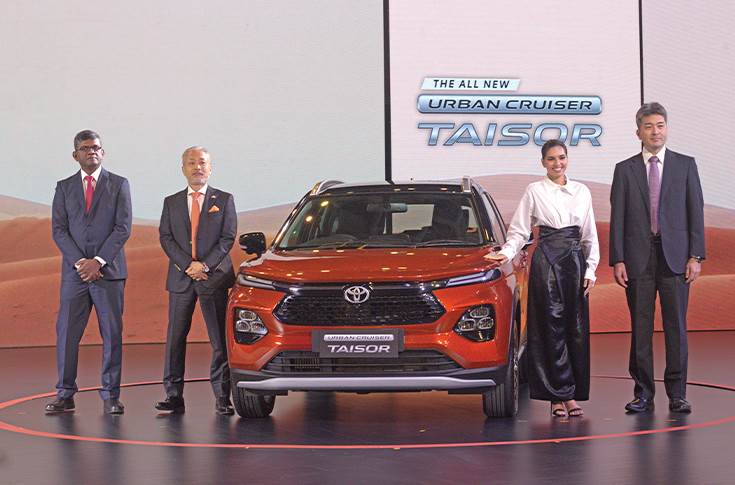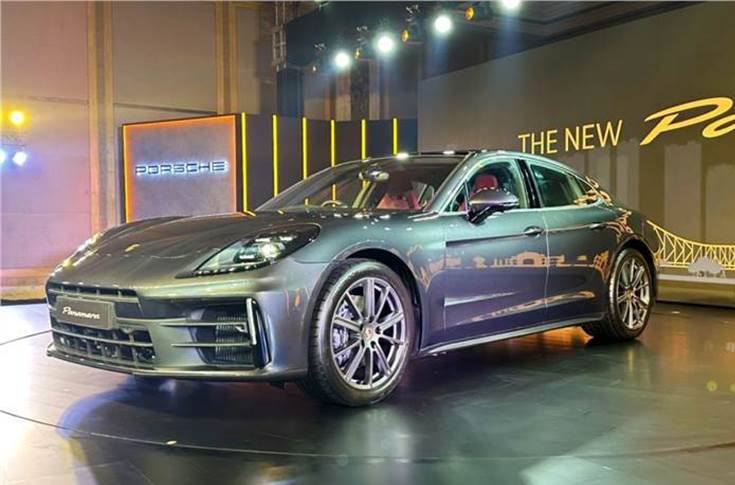Despite the dynamic nature of India’s car market, Toyota has managed to orchestrate a remarkable turnaround; the automaker has emerged as a formidable contender after remaining a niche player for years, with their market share hovering a little over 2%. Their current share for FY24 rose to 5.3%, according to the latest figures from the Federation of Automobile Dealers Associations of India (FADA).
This jump is thanks to the Japanese automaker’s global partnership with Suzuki, carefully crafted to navigate the intricacies of the Indian market and swiftly infiltrate segments where its presence was once limited. Toyota’s latest launch, the Urban Cruiser Taisor — a rebadged Maruti Suzuki Fronx — was done bearing these factors in mind. Representing a calculated resurgence into the sub-4m segment, the Taisor is a testament to Toyota’s ambition to carve out a substantial foothold in India.
In a move aimed at capturing a larger slice of the country’s burgeoning SUV space, Toyota’s re-entry into the sub-4m SUV category nine months after discontinuing the Urban Cruiser — their version of the Maruti Suzuki Brezza — shows that they have bigger goals. But will the gamble pay off?
Nailing the pricing
One of the reasons Toyota discontinued the Urban Cruiser last year was the large premium the model demanded over its Maruti Suzuki counterpart. With SUVs commanding a significant share of overall wholesales, Toyota faces immense pressure to deliver a compelling product that resonates with Indian consumers.
Despite these challenges, the brand remains optimistic about the prospects of the Taisor in India. The company believes that this car will attract a new segment of customers to its fold, thereby bolstering its market presence here. Priced competitively between Rs 7.73 lakh and Rs 13.03 lakh (ex-showroom), the Taisor aims to strike a balance between affordability and performance, catering to the diverse needs of Indian consumers. This is very close to the tag of Maruti Fronx, which starts at Rs 7.51 lakh ex-showroom for the Sigma (petrol) variant.
“This will allow a new set of customers to experience the brand. That’s the key factor. This also completes our entire lineup of SUVs,” Vikram Gulati, Country Head and Executive Vice President at Toyota Kirloskar Motor (TKM), told Autocar Professional, adding that understanding consumer preferences and identifying the sweet spot where a compact size meets an SUV’s capabilities is where the Taisor took birth.
Positioned as a compact SUV, the car also faces pressure to compete with established models like the Kia Sonet, Hyundai Venue, Tata Nexon and Mahindra XUV300. In recent years, this segment has enjoyed the most traction.
The Toyota-Maruti mix
The Maruti Suzuki-Toyota collaboration first started with the Baleno, which Toyota sells as the Glanza, a model that’s still going strong for the company. This was followed by the Urban Cruiser that’s based on the Brezza and the Hyryder, based on the Grand Vitara. More recently, Maruti Suzuki took the popular Innova Hycross and rebadged it as the Invicto. The Taisor is the sixth shared product between the two automotive giants in India, and there will also be a Maruti Suzuki Ertiga-based Toyota Rumion MPV.
So far, Toyota didn’t have an SUV in the sub-4m space starting under Rs 10 lakh. Leveraging the success of products like the Fronx, the company now aims to infuse the Taisor with its distinct identity, while offering customers a familiar platform renowned for its reliability and performance.
“Taisor is positioned in the A- SUV segment and will be our welcoming model for new and replacing customers. It will help us bring new customers to the Toyota family and make them experience the vehicle with the 650 touchpoints we have in the country,” said Sabari Manohar, Vice President – Sales-Service-Used Car Business, Toyota Kirloskar Motor.
This new addition to their portfolio will complement their existing SUV lineup, comprising the LC300, Legender, Fortuner, Hilux and Urban Cruiser Hyryder, as they continue to uphold strong positions in their respective segments.
The energy mix
Navigating this transition to green energy, including electric, while maintaining a competitive edge, would pose a significant challenge. Another key consideration for Toyota going forward would be to consider tapping into India’s growing preference for CNG vehicles. While the Maruti Fronx offers a CNG option with its 1.2-litre petrol engine, Toyota has yet to include a CNG variant for the Taisor. Here, industry experts speculate that Toyota might introduce a CNG variant later to capitalise on its increasing popularity. TKM, which also had a significant presence in the diesel segment, said post BSVI, the emission levels are almost similar for diesel, petrol, CNG, etc.
“The perception that diesel is a bad fuel is a thing of the past. Another factor is the belief that carbon is critical for any fuel. So, as diesel is much more efficient, it’s favourable,” Gulati said. “Having said that, different fuels meet different customer needs, and segments behave very differently when it comes to fuel mixes. Plus, in larger segments, there’s still a demand for diesel.”
Unphased by any potential technological challenge, Gulati added that upgrades were simply a means to achieve carbon neutrality. “Whatever tech is able to best deliver at the fastest scale will work to transition away from fossil fuels. The answer to this is different for different markets. Given the size and scale of India, all technologies will remain relevant depending on customer preference,” he explained.
On looking to bring in more premium models in the country, Tadashi Asazuma, Deputy Managing Director, Sales-Service-Used Car TKM and Lexus, said: “The company plans to have models with diverse powertrains, including hybrid and battery EVs, in its portfolio in the country. In India’s case at present, we believe strong hybrid vehicles are the practical solution. But with more and more customer requirements coming in, we will consider BEVs.”
The penetration strategy
One reason Toyota was expanding its production capacity with a new manufacturing plant to offer new models was the gradual shift from small to bigger cars. Asazuma acknowledged: “Last year, we announced our plan to build a new plant in Bidadi [on the outskirts of Bengaluru]. That’s to be prepared to meet customer demand. The new facility is expected to commence production in 2026.”
With this new factory, the company plans to increase capacity by 1 lakh units. It’s also looking to expand its touchpoints deeper into the Indian market.
“To enhance the availability of our products, we’ve added the third shift, which has added a capacity of 30% up to 33,000 units. We also announced our new plant in Bidadi. With both initiatives, our capacity will go up to 4.45 lakh units from the present 3.45 lakh,” Gulati highlighted.
Masakazu Yoshimura, Managing Director and CEO of TKM and Regional CEO at Toyota Motor Corporation, emphasised that India was of paramount importance to the company, both in terms of product offerings and introduction of advanced technologies. This point, he said, was further proved by the recent creation of a new region, “where the Indian market plays an even more crucial role, acting as the hub for India, the Middle East, East Asia and the Oceania Region.” Looking forward, their business strategy, Yoshimura said, will be to continue to focus on contributing to national priorities of localisation, developing a highly skilled workforce, achieving carbon goals, as well as defining their market strategy with their customer-first culture
Toyota is also planning to export the Taisor to its key markets, including West Asia. In 2023, they exported 15,000 cars, Gulati said, besides exporting automobile components from India.
This feature was first published in Autocar Professional’s April 15, 2024 issue.



